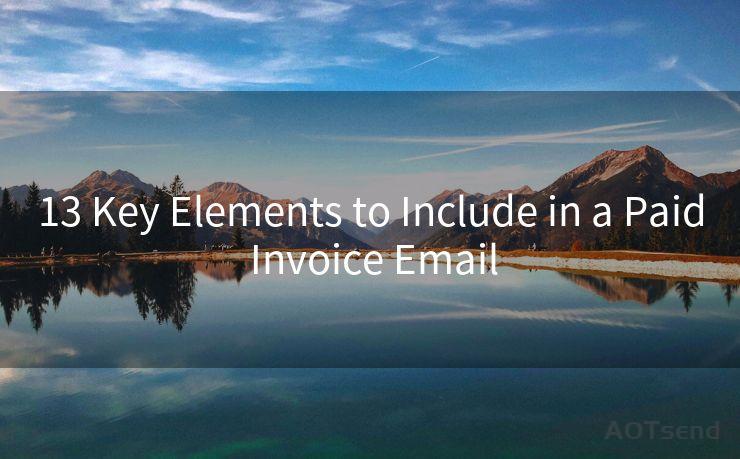13 Key Elements to Include in a Paid Invoice Email




When it comes to business transactions, a paid invoice email serves as crucial documentation. It not only confirms payment but also provides important details about the transaction. To ensure clarity and professionalism, here are the 13 key elements you should include in a paid invoice email.
1. Clear Subject Line
Start with a clear and concise subject line that immediately informs the recipient about the content of the email. For example, “Confirmation of Payment for Invoice #XYZ123”.
2. Greeting and Introduction
Begin the email with a formal greeting, addressing the recipient by name if possible. Briefly introduce the purpose of the email, which is to confirm payment of the invoice.
🔔🔔🔔
【AOTsend Email API】:AOTsend is a Managed Email Service for sending transactional emails. Support Email Types: reminders, authentication, confirmations, notifications, verification codes, invoices, password resets, account activations, billing statements, two-factor authentication (2FA), and one-time passwords (OTP) emails, etc. $0.28 per 1000 Emails. 99% Delivery, 98% Inbox Rate.
You might be interested in:
Why did we start the AOTsend project, Brand Story?
What is a Managed Email API, How it Works?
Best 25+ Email Marketing Platforms (Authority,Keywords&Traffic Comparison)
Best 24+ Email Marketing Service (Price, Pros&Cons Comparison)
Email APIs vs SMTP: How they Works, Any Difference?
3. Invoice Details
Provide the invoice number, date, and the total amount paid. This helps the recipient quickly identify and verify the transaction.
4. Payment Method and Confirmation
Specify the payment method used (e.g., credit card, wire transfer, etc.) and include any relevant transaction details such as transaction IDs or confirmation numbers.
5. Services or Products Provided
List the services rendered or products sold that this payment covers. This adds clarity and can be used for future reference.
6. Payment Terms and Conditions
If there are any special terms or conditions related to the payment, such as refund policies or warranties, mention them here.
7. Tax Information
Include details about taxes, if applicable. Specify the tax rate, the taxable amount, and the total tax paid.
8. Contact Information
Provide your contact information in case the recipient has any questions or concerns about the payment.
9. Thank You Note
Express gratitude for the payment. A simple “Thank you for your prompt payment” suffices and leaves a positive impression.
10. Next Steps or Follow-Up Actions
If there are any follow-up actions required, such as delivering additional services or products, outline them here.

11. Attachments
If you’re attaching any documents, such as a receipt or a copy of the paid invoice, mention this in the email.
12. Disclaimer or Legal Notice
If necessary, include a disclaimer or legal notice related to the payment or the services/products provided.
13. Closing Statement
End the email with a professional closing statement, thanking the recipient again and encouraging them to contact you if they have any questions.
By including these 13 key elements in your paid invoice email, you ensure clarity, professionalism, and efficiency in your business communication. Remember to tailor the email to your specific business needs and always maintain a polite and professional tone.
Incorporating these elements into your paid invoice emails will not only streamline your business processes but also enhance your brand image and customer satisfaction. By providing all the necessary information in a structured and clear format, you demonstrate your commitment to transparency and professionalism.




Scan the QR code to access on your mobile device.
Copyright notice: This article is published by AotSend. Reproduction requires attribution.
Article Link:https://www.mailwot.com/p3768.html



